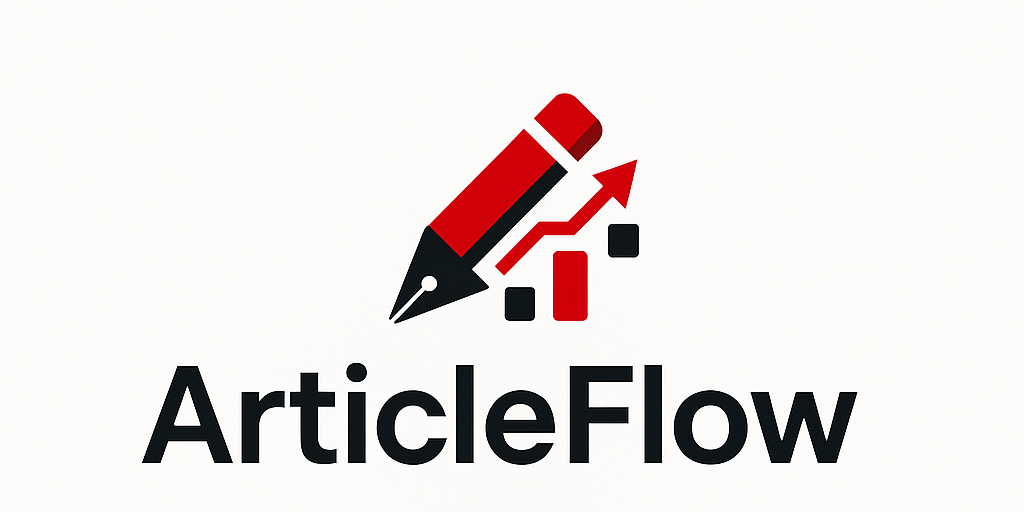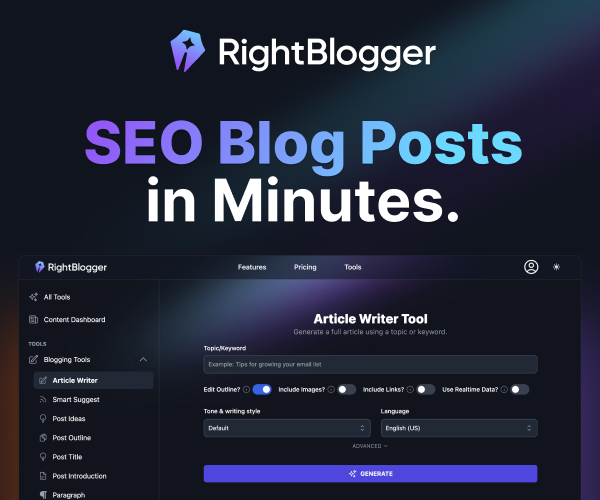Boost Rankings and Sales with AI, SEO, and Bespoke Blogging
Discover cheerful and easy Website Design Tips for Small Business owners. Create inviting pages that guide visitors and boost your online presence every day.
Ranking higher, getting more traffic, or keeping up with solid blog posts can feel like a puzzle—especially for small business owners juggling it all.
The good news? Yes, great website design really does transform your results, making SEO easier, pulling in the right clicks, and helping you stay ahead in your niche.
Clear, user-friendly design connects with your audience while modern tools like AI and Artificial Intelligence take the heavy lifting out of content planning and Blogging.
In this guide, you’ll find simple website design tips for small businesses, practical examples, and ways to use AI-assisted SEO writing to save time and drive steady growth.
Need something completely tailored? Services like the Article Flow website-building service give you a head start by blending beautiful design with data-driven SEO.
Get set to discover actionable strategies, helpful links, and the confidence to grow, even on a tight schedule.
Why Website Design Matters for Small Businesses
A strong online presence sets successful small businesses apart from those that struggle. With so many choices online, it’s not enough to just have a website. That website has to work for you—supporting your goals and lifting your brand.
Good design does more than make a site look nice; it quietly builds trust, guides your visitors, and fuels growth through SEO and effective Blogging.
Let’s look at how smart website design tips for small business owners can directly shape results, from better search rankings to more sales.
The Relationship Between Website Design and SEO
Your design choices influence everything from how easily Google can read your site to how visitors interact and convert.
When a site looks cluttered or is slow to load, users bounce away, which bumps up your bounce rates and tells search engines your content isn’t meeting expectations.
Effective website design and SEO go hand in hand. Small tweaks—a logical navigation structure, well-organized headings, and speedy load times—make it easier for customers and search engines to find what matters.
Here are a few website design tips for small business owners hoping to grow with SEO:
- Use a clear page hierarchy with headings.
- Limit clutter and distraction in navigation menus.
- Choose fast, lightweight design elements.
- Keep key content above the fold, where people will see it first.
Pairing these fundamentals with a strong keyword strategy is where the magic happens.
Brush up on basics with our SEO Keyword Research Guide, which breaks down how to pick winning keywords for your Blogging and web pages.
To see how smart design touches everything from rankings to bounce rates, you can check out the deeper dive at 4 Ways Website Design Affects SEO.
Looking to save time or need ready-made blog posts? Explore our AI-powered help for content and SEO at the AI Blogging and Content Creation Services.
Mobile Optimisation: A Must for Modern Audiences
 Photo by RDNE Stock project
Photo by RDNE Stock project
Nearly everyone uses smartphones to search and shop. Google now gives priority to the mobile version of your site for ranking and indexing—a shift called mobile-first indexing.
If your website isn’t fully responsive, you risk dropping in search results and frustrating visitors.
What does mobile optimisation mean in 2024? Here are some keys:
- Use a responsive template that adapts design elements and fonts for every screen size.
- Test clickable elements (like buttons and menu items) for easy tapping.
- Compress images for faster loading without losing quality.
- Avoid tiny text and overcrowded layouts on small devices.
- Hide or simplify complex graphics that clutter small screens.
Curious about what Google recommends? Read Mobile-first Indexing Best Practices for details and a checklist to spot issues.
Optimising for mobile is no longer optional. You want quick-loading pages and layouts that work for all customers, no matter how they reach your site.
Visual Appeal vs. Functional Simplicity
For small businesses, flashy designs can backfire if they distract from your message.
A good website looks professional but always puts clarity and ease of use first.
Balance comes from focusing on these areas:
- Layout: Stick to simple, familiar site structures. Try a single-column design for the most important pages. Put your logo in the top left, keep menus clear, and use plenty of white space.
- Colours: Choose a palette that fits your brand and is easy on the eyes. Use one main color for highlights—think buttons and calls to action—so these key elements stand out. For inspiration, browse Designer-approved website color schemes.
- Fonts: Pick clear, readable fonts. Stick with two font styles at most (one for headings, one for text).
- Calls to Action: Highlight actions you want visitors to take. Use bold text, a contrasting color, or a well-placed button that draws the eye.
A tidy, confident visual style means your calls to action—whether it’s to shop, contact, or sign up—are never lost in the clutter.
Don’t want to hassle with the fine details? Our website building service takes care of both visual appeal and functionality, tailored to your business.
By putting these website design tips for small business into practice, you set your brand up as one of the niche builders—sites that carve out their own space online with confidence, clarity, and impact.
Ready to skyrocket your rankings, simplify your Blogging, or see the benefits of AI and Artificial Intelligence in action?
Discover more bespoke solutions at Article Flow.
Key Website Design Tips to Elevate Your Small Business Online
Clear, focused website design will shape how people see your brand and act on your offers. Powerful tools like AI, smart Blogging, and layouts built for trust can lift your results without much fuss.
Here are some direct website design tips for small business owners who want less stress, more traffic, and steady growth.
Harnessing AI and Automation in Website Design
Artificial Intelligence isn’t only for big companies or tech geeks.
These days, AI makes updating, customising, and optimising your site simple, even for small businesses with limited staff or know-how.
 Photo by Eva Bronzini
Photo by Eva Bronzini
How can AI and automation help?
- Content Updates: AI tools can help schedule, write, and even suggest updates for your blog posts. You can focus on your business, while AI keeps your content fresh and relevant.
- User Customisation: AI looks at visitor behavior and suggests content, products, or services that match their interests. This makes every visit feel more personal and engaging.
- SEO Made Simple: Modern AI-driven platforms recommend keywords, help organise site structure, and even check your SEO on the fly. This saves you hours and avoids mistakes.
Some business owners use AI website builders for a head start.
Services reviewed in I Tested 6 AI Website Builders: Which Should You Use? show how these tools can customize layouts, add content, and make your site search-engine ready in minutes.
For businesses ready to truly stand out, our AI blogging services take the guesswork out, giving you SEO-optimized updates and unique blog posts for your audience.
Strategic Content Placement and Blogging Best Practices
How your content is placed on your website changes everything—from how much traffic you get, to whether visitors trust your offers.
Placing key information upfront and using a blog keeps your site active and easy to find.
A blog does much more than fill up space:
- Drives Engagement: Fresh articles on topics your audience cares about keep them coming back.
- Boosts Search Rankings: Google likes active websites with new blog posts. Every post is a new door for people to discover your business.
- Builds Authority: Sharing solutions, tips, or client stories proves you know your stuff in your field.
Smart content placement keeps your business top of mind:
- Keep important updates and calls to action in visible spots—above the fold and on the front page.
- Use headings and short paragraphs so people can skim for answers.
- Link related topics inside your articles. If you talk about a topic, suggest another helpful post with a direct link.
Internal linking is key to keeping people browsing your site longer.
When you’re planning posts, look at services like Building niche websites with AI for ideas on how AI chooses topics and places content to build your authority as one of the niche builders in your field.
For deep insights, check out The Ultimate Guide to Content Placement in 2025—you’ll see how top sites place stories, blog posts, and internal links to keep audiences engaged.
Conversion-Focused Design Elements
The true power of your website shows up when visitors do what you want—contact you, sign up or buy. With the right layout and signals, your site can turn more guests into customers.
Here’s how to make every visit count:
- Clear Navigation: Menus should be simple, with key sections up front. If it takes too long to find something, visitors give up.
- Calls to Action (CTAs): Use buttons that stand out—contrast color, easy text like “Get a Quote” or “Book Now.” Place them often, not just at the page’s end.
- Trust Signals: Share real reviews, clear contact info, and professional badges. A neat “About” or “Why Choose Us” section also builds peace of mind.
Actionable tips for better conversions:
- Make your contact or signup forms short and simple.
- Add testimonials to key pages for proof.
- Offer a clear route to your main service—like a direct link to your website design service or blog.
If you’d like to go deeper on user psychology and what keeps customers moving toward your offers, this detailed guide shares more strategies to fine-tune your pages for sales and signups.
Smart website design tips for small business, combined with AI, clear strategy and trust-building layout, will give your small business a strong online voice.
If you want ready-to-go solutions, explore AI blogging services and boost your site with fresh, targeted content that brings real results.
Long-term Growth: Keeping Your Website Competitive
Building a great website is not a one-off job—you need to nurture, measure, and grow it if you want your small business to stay ahead.
Long-term growth means checking in often, making smart adjustments, and creating reasons for people to return.
With AI, SEO, and a few thoughtful engagement strategies, you can keep your site fresh and competitive no matter how quickly things change online.
Analysing Performance with AI and SEO Tools
You can’t improve what you don’t measure. Using Artificial Intelligence and analytics is like having x-ray vision for your website’s health.
Modern SEO tools and AI-powered platforms look at which blog posts get the most attention, which pages users linger on, and where they drop off.
This data shows you what’s working and where your site could use a boost.
 Photo by Mikhail Nilov
Photo by Mikhail Nilov
To refine your website design and content, try these steps:
- Set up Google Analytics: See which pages attract the most visitors and where your traffic is coming from.
- Review SEO performance: Track keyword rankings and how many clicks your pages get from search.
- Use heatmaps: Tools like Hotjar or Microsoft Clarity show where users click, scroll, or get stuck.
- Let AI suggest improvements: Many platforms now use Artificial Intelligence to highlight popular keywords, spot thin content, or flag slow-loading pages.
Acting on this data matters. Maybe your “About” page isn’t getting visits—move it to the main menu or make your brand story punchier. If your top SEO blog posts are about a certain product, write more on that topic or link to services related to it.
Want hands-off help? Many small businesses cut guesswork with services like AI blogging and content creation, which blend analytics with fresh, SEO-optimized updates.
Curious how analytics power niche builders? See our profitable niche finding tips for more on making smart, data-led site decisions.
Regular checks and tweaks set your website up for steady, compounding growth by keeping your SEO sharp and your brand message clear.
Encouraging User Engagement and Loyalty
Getting a new visitor is great—but having them come back, join your email list, or leave a comment is even better.
Engagement keeps your business top-of-mind and makes your website a living community, not just an online brochure.
How can you foster real user engagement? It starts with making everyone feel like part of something special:
- Start a newsletter: Offer tips, discounts, or behind-the-scenes peeks. A simple signup form lets you reach out directly whenever you launch new products or post updates.
- Enable blog comments: Invite your readers to ask questions or share their own tips. Responding to comments shows you care and builds relationships.
- Share exclusive content: Members-only guides, early bird access, or free tools can turn casual browsers into loyal fans.
- Repurpose top blog posts: Give extra value by turning popular articles into videos, infographics, or ebooks. This helps people engage in their favorite way.
Think about what would make you come back to a website. Is it a helpful weekly tip? A chance to connect with the owner?
The feeling that your feedback matters? Little touches like these set great small business sites apart from the rest.
Looking for more ways to boost engagement? Our tips on Repurposing blog content for SEO outline how to reach different types of visitors and give each post a longer life.
If you’re eager to grow your community and traffic together, check out how to increase blog traffic with proven strategies.
Remember, long-term growth isn’t just about pulling in new eyes. It’s about building lasting connections that help your brand and your bottom line.
That’s the secret sauce for small business website success.
Conclusion
A smart approach to website design can transform any small business, creating real opportunities for growth, better SEO, and stronger brand trust.
By putting clear website design tips for small business into action and exploring tools like AI and Artificial Intelligence, business owners gain more than just a modern look—they unlock smarter Blogging, consistent traffic, and efficient content updates.
Choosing a service that understands these needs saves time and brings long-lasting results.
Our bespoke AI-assisted SEO writing services are built to do just that, giving you tailored Blog Posts and content that keep your audience engaged and your rankings climbing.
The results speak for themselves: sharper SEO, a site that’s easy to navigate, and the freedom to focus on growing your business instead of chasing the next Blogging trend.
Curious how top Niche Builders keep winning year after year? Check out actionable ideas in our Niche Site Success Tips, designed for anyone ready to boost their results with tried-and-true strategies.
Ready to skyrocket your website’s rankings and see what AI-powered, expertly written content can do for your site?
Discover our bespoke AI-assisted SEO writing services and let us help you stand out online.
Stay tuned—future case studies and fresh tips are coming soon to help you keep your website ahead of the curve.
Thanks for reading and sharing your time. If you have questions or want to connect, drop us a message and let’s build something great together.








